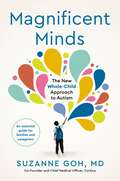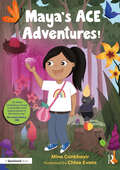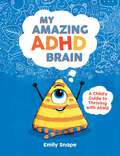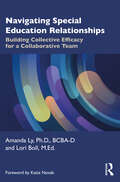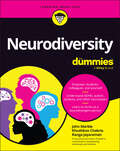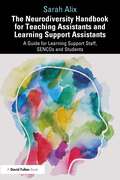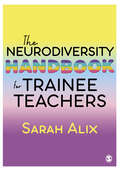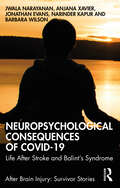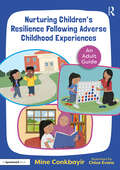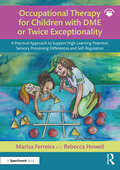- Table View
- List View
Magnificent Minds: The New Whole-Child Approach to Autism
by Dr Suzanne Goh“For years, I searched for a book that I could recommend to parents—those just beginning to learn about autism as well as those with decades of experience. I looked for a book with all the essential information—the liquid gold—something a busy parent could get through while keeping up with the demands of life. I couldn’t find that book, so I decided to write it.”Dr Suzanne Goh is a renowned paediatric neurologist who has spent decades working with autistic children. In this ground-breaking book, Goh combines her extensive experience with original research to give you a clear understanding of what autism is and how to create a holistic treatment roadmap for your child.Based on Goh’s revolutionary ‘whole child approach,’ you’ll discover how to:- Best support every aspect of your child’s health- Get the help you need and build a strong and supportive team- Make informed decisions based on a deep understanding of your child’s brain and bodyMost importantly, Magnificent Minds will show you how to recognise and nurture your child’s innate strengths – their intelligence, abilities, and gifts – and celebrate their neurodiverse magnificence.
Maya's ACE Adventures!: A Story to Celebrate Children's Resilience Following Adverse Childhood Experiences (Maya's ACE Adventures!)
by Mine ConkbayirFor effective use, this book should be purchased alongside the accompanying adult guide, Nurturing Children’s Resilience following Adverse Childhood Experiences: An Adult Guide [9781032368184]. Both books can be purchased together as a set, Helping Children to Thrive After Adverse Childhood Experiences: ‘Maya’s ACE Adventures!’ Storybook and Adult Guide [9781032367934]. Maya knows that her life can be tough sometimes – really tough, but with the help of those she trusts (especially her pet hamster, Harry) Maya discovers her own strength and bravery to overcome the problems she faces. By day, Maya is a girl who loves drawing and playing football, but she often feels sad and angry when her mum and her boyfriend argue, or when she is visiting her dad in prison. By night, Maya is an adventurer – meeting exotic creatures in a kaleidoscopic forest, scuba diving in the ocean, and going head-to-head with bullies at a fantastical circus – who faces her fears, helps others, and knows just what to do to overcome her problems. As her dreamworlds and real world collide, Maya learns how to conquer life’s challenges with the love and support of her family, friends and schoolteacher, Miss Hero. Beautifully illustrated by Chloe Evans and with a Foreword by Lenny Henry CBE, Maya’s ACE Adventures! is both a magical adventure for readers of 7+ and a creative tool to foster hope and resilience for children who have survived traumatic experiences.
Maya's ACE Adventures!: A Story to Celebrate Children's Resilience Following Adverse Childhood Experiences (Maya's ACE Adventures!)
by Mine ConkbayirFor effective use, this book should be purchased alongside the accompanying adult guide, Nurturing Children’s Resilience following Adverse Childhood Experiences: An Adult Guide [9781032368184]. Both books can be purchased together as a set, Helping Children to Thrive After Adverse Childhood Experiences: ‘Maya’s ACE Adventures!’ Storybook and Adult Guide [9781032367934]. Maya knows that her life can be tough sometimes – really tough, but with the help of those she trusts (especially her pet hamster, Harry) Maya discovers her own strength and bravery to overcome the problems she faces. By day, Maya is a girl who loves drawing and playing football, but she often feels sad and angry when her mum and her boyfriend argue, or when she is visiting her dad in prison. By night, Maya is an adventurer – meeting exotic creatures in a kaleidoscopic forest, scuba diving in the ocean, and going head-to-head with bullies at a fantastical circus – who faces her fears, helps others, and knows just what to do to overcome her problems. As her dreamworlds and real world collide, Maya learns how to conquer life’s challenges with the love and support of her family, friends and schoolteacher, Miss Hero. Beautifully illustrated by Chloe Evans and with a Foreword by Lenny Henry CBE, Maya’s ACE Adventures! is both a magical adventure for readers of 7+ and a creative tool to foster hope and resilience for children who have survived traumatic experiences.
The Mental Health and Wellbeing of Children and Young People with Learning Difficulties: A Guide for Educators
by Kirstie ReesKnowing when children and young people are struggling, and identifying the best ways of supporting them is vital. This is all the more important when working with children with varying learning difficulties who may not always be able to communicate their feelings.By demystifying terms such as mental health, wellbeing, learning difficulties and the sensitivities surrounding labels, this practical and evidence-based guide helps you achieve an in-depth understanding of the children and young people you work with. It provides you with skills and knowledge for supporting their mental health and wellbeing in educational settings - from nursery to secondary school in both mainstream and specialist environments with talking and non-verbal communication approaches to accommodate varying needs. Most importantly its holistic approach explores the interaction between the child's learning difficulties and the psychological, social and environmental factors which influence how they manage their ups and downs in life. This lets you think beyond the child and the classroom.
My Amazing ADHD Brain: A Child's Guide to Thriving with ADHD
by Emily SnapePip is a confident little monster who has ADHD. In this book, they share what that means for them and how it has some really brilliant benefits.My Amazing ADHD Brain is packed with reassuring words, practical advice and skill-building activity ideas, and has a fun, relatable voice.
Navigating PDA in America: A Framework to Support Anxious, Demand-Avoidant Autistic Children, Teens and Young Adults
by Ruth Fidler Diane GouldAlthough Pathological Demand Avoidance (PDA) has been a recognized autistic profile in the UK for some time, awareness is still growing in America. When parents first learn about it they talk about having a lightbulb moment of understanding their child better. Many described how, having found traditional parenting and behavioral techniques made things worse instead of better, they felt judged and alone. Teachers and school administrators also reported struggling to support their PDA students. The children, teens and young adults themselves were often left feeling misunderstood.The authors of this book explain PDA with an emphasis on promoting well-being both for PDA individuals and all those who support them. They provide a neurodiversity-affirming framework for supporting anxious, demand avoidant individuals across a range of settings and services. As awareness spreads across the pond, the compassion and clarity in this book will become a valuable guide to many.
Navigating Special Education Relationships: Building Collective Efficacy for a Collaborative Team
by Amanda Ly Lori BollTold through a series of real-life stories and hard-learned lessons, Amanda Ly and Lori Boll share the challenges in special education relationships experienced through the lens of a special educator, a parent of a son with profound disabilities, and a child psychologist.Ideally, teachers, therapists, and parents working with students with special needs should form a cohesive team. However, these three parties often function as separate entities with different goals and objectives. Over the past 25 years, the authors have observed a consistent pattern of miscommunication and overlooking the importance of the mental and physical well-being of each team member, which contributed to poor collaboration. This book takes readers on a journey through the process of discovering whether you have, or are working with, a student with special needs; navigating how to best work with the student and other members of the team; and lastly, discussing ways to empower the reader and all members of the team. The authors posit that if we understand one another's perspectives, learn how to communicate more effectively, and focus on self-care, we will increase Collective Efficacy and become the collaborative team our students need us to be.As the first book to connect the concept of Collective Efficacy to special education, this is a must-read for teachers, therapists, and parents aiming to grasp the complexities of relationships in special education teams and better understand how mental health influences the effectiveness of each individual’s role.
Navigating Special Education Relationships: Building Collective Efficacy for a Collaborative Team
by Amanda Ly Lori BollTold through a series of real-life stories and hard-learned lessons, Amanda Ly and Lori Boll share the challenges in special education relationships experienced through the lens of a special educator, a parent of a son with profound disabilities, and a child psychologist.Ideally, teachers, therapists, and parents working with students with special needs should form a cohesive team. However, these three parties often function as separate entities with different goals and objectives. Over the past 25 years, the authors have observed a consistent pattern of miscommunication and overlooking the importance of the mental and physical well-being of each team member, which contributed to poor collaboration. This book takes readers on a journey through the process of discovering whether you have, or are working with, a student with special needs; navigating how to best work with the student and other members of the team; and lastly, discussing ways to empower the reader and all members of the team. The authors posit that if we understand one another's perspectives, learn how to communicate more effectively, and focus on self-care, we will increase Collective Efficacy and become the collaborative team our students need us to be.As the first book to connect the concept of Collective Efficacy to special education, this is a must-read for teachers, therapists, and parents aiming to grasp the complexities of relationships in special education teams and better understand how mental health influences the effectiveness of each individual’s role.
Neurodiversity and the Twice-Exceptional Student: A Comprehensive Resource for Teachers
by Rhonda FilmerWritten for busy teachers, this practical manual defines terms, shares examples and provides evidence-based information and strategies to support the teaching of twice-exceptional students. Providing a comprehensive blueprint in an easy-to-use format, this book explains classroom techniques for differentiation with tips and advice based on research and teacher experience. The topics covered include learning disabilities, gifted and high potential education, talent development and general classroom pedagogy involving curriculum differentiation and individualised programming. It also explains, in more depth, the varying presentations of neurodiversity in the form of specific learning disabilities, autism and attention deficits in the gifted/high potential student to enable teachers to acquire more knowledge of the nuances evident in each twice-exceptional student. Case studies capture the perspectives of twice-exceptional young people who have thrived, and the book provides weblinks to a very comprehensive list of helpful, freely-available resources.This essential, practical resource will serve teachers and educators in both primary and secondary schooling, as well as pre-service educators. It will also be of interest to parents and carers.
Neurodiversity and the Twice-Exceptional Student: A Comprehensive Resource for Teachers
by Rhonda FilmerWritten for busy teachers, this practical manual defines terms, shares examples and provides evidence-based information and strategies to support the teaching of twice-exceptional students. Providing a comprehensive blueprint in an easy-to-use format, this book explains classroom techniques for differentiation with tips and advice based on research and teacher experience. The topics covered include learning disabilities, gifted and high potential education, talent development and general classroom pedagogy involving curriculum differentiation and individualised programming. It also explains, in more depth, the varying presentations of neurodiversity in the form of specific learning disabilities, autism and attention deficits in the gifted/high potential student to enable teachers to acquire more knowledge of the nuances evident in each twice-exceptional student. Case studies capture the perspectives of twice-exceptional young people who have thrived, and the book provides weblinks to a very comprehensive list of helpful, freely-available resources.This essential, practical resource will serve teachers and educators in both primary and secondary schooling, as well as pre-service educators. It will also be of interest to parents and carers.
Neurodiversity For Dummies
by John Marble Khushboo Chabria Ranga JayaramanA quick and easy way to understand neurodiversity as written by neurodivergent people and our families Neurodiversity For Dummies is your essential guide in understanding neurodivergent conditions like autism, ADHD, dyslexia, and more. This quick and easy guide is perfect for anyone needing to know more about neurodiversity. And that’s all of us—because recent estimates say that 15-20% of the world’s population have some form of neurodivergence. Your life is filled with neurodivergent people that you know and love, whether you realize it yet or not. It’s time to learn to support and include the neurodivergent among us, and to understand how neurodiversity impacts society and the workplace. This is for the neurodivergent person wanting to thrive in life, for parents and caregivers seeking success for their child, and for teachers who are working to make a difference in their students’ lives. Filled with practical advice, Neurodiversity for Dummies also provides a helping hand to service providers, assistance for workplace managers and colleagues, and understanding for family members and friends. Imagine a world where we all understood ourselves better and appreciated more deeply the differences in others. No matter how your own brain thinks, Neurodiversity for Dummies is for you. Check out this jargon-free introduction for an essential overview. Explore the Spectrum of Neurodiversity: Understand in plain language the world of autism, ADHD, dyslexia, and other neurodivergent conditions. Unlock Hidden Talents: Move yourself beyond common myths and misconceptions to discover how neurodiversity actually works. Learn how neurodiversity has always been with us, why society needs neurodivergent traits, and how neurodiversity can be a wellspring of innovation, creativity, and out-of-the-box thinking. Discover Yourself: Whether you are a neurodivergent person or not, learn how to understand your own normalcy, advocate for your needs, and build meaningful connections with those who think and experience the world differently than you. Change the World Around You: Be empowered through simple steps you can take to create inclusive environments for neurodivergent individuals in your school or workplace. Uncover proven strategies that cultivate a culture of acceptance and respect, where the unique perspectives of all individuals are valued and celebrated. We believe in providing parents with better supports, empowering individuals with information, and shaping a world where we are all seen and understood. With an author team composed of neurodivergent individuals and parents writing together, Neurodiversity for Dummies is an example of the power of neurodiversity when put into action. It’s why we wrote this for you. Don’t miss your chance to embark on this transformative journey. Order your copy of Neurodiversity for Dummies now to better understand yourself and others, and to join the movement that is revolutionizing how we understand and support the diversity of the human mind.
Neurodiversity For Dummies
by John Marble Khushboo Chabria Ranga JayaramanA quick and easy way to understand neurodiversity as written by neurodivergent people and our families Neurodiversity For Dummies is your essential guide in understanding neurodivergent conditions like autism, ADHD, dyslexia, and more. This quick and easy guide is perfect for anyone needing to know more about neurodiversity. And that’s all of us—because recent estimates say that 15-20% of the world’s population have some form of neurodivergence. Your life is filled with neurodivergent people that you know and love, whether you realize it yet or not. It’s time to learn to support and include the neurodivergent among us, and to understand how neurodiversity impacts society and the workplace. This is for the neurodivergent person wanting to thrive in life, for parents and caregivers seeking success for their child, and for teachers who are working to make a difference in their students’ lives. Filled with practical advice, Neurodiversity for Dummies also provides a helping hand to service providers, assistance for workplace managers and colleagues, and understanding for family members and friends. Imagine a world where we all understood ourselves better and appreciated more deeply the differences in others. No matter how your own brain thinks, Neurodiversity for Dummies is for you. Check out this jargon-free introduction for an essential overview. Explore the Spectrum of Neurodiversity: Understand in plain language the world of autism, ADHD, dyslexia, and other neurodivergent conditions. Unlock Hidden Talents: Move yourself beyond common myths and misconceptions to discover how neurodiversity actually works. Learn how neurodiversity has always been with us, why society needs neurodivergent traits, and how neurodiversity can be a wellspring of innovation, creativity, and out-of-the-box thinking. Discover Yourself: Whether you are a neurodivergent person or not, learn how to understand your own normalcy, advocate for your needs, and build meaningful connections with those who think and experience the world differently than you. Change the World Around You: Be empowered through simple steps you can take to create inclusive environments for neurodivergent individuals in your school or workplace. Uncover proven strategies that cultivate a culture of acceptance and respect, where the unique perspectives of all individuals are valued and celebrated. We believe in providing parents with better supports, empowering individuals with information, and shaping a world where we are all seen and understood. With an author team composed of neurodivergent individuals and parents writing together, Neurodiversity for Dummies is an example of the power of neurodiversity when put into action. It’s why we wrote this for you. Don’t miss your chance to embark on this transformative journey. Order your copy of Neurodiversity for Dummies now to better understand yourself and others, and to join the movement that is revolutionizing how we understand and support the diversity of the human mind.
The Neurodiversity Handbook for Teaching Assistants and Learning Support Assistants: A Guide for Learning Support Staff, SENCOs and Students
by Sarah AlixThis highly practical book supports the knowledge and development of teaching assistants and learning support assistants (TAs/LSAs) in their understanding of neurodivergent pupils. Considering a neurodivergent world is vital in society today, and even more so in the classroom. Starting with a model of difference rather than deficit and highlighting the complexities involved, this accessible resource focuses on effective strategies to support these pupils and explores the vital role of learning support in a range of different contexts. Rich in pedagogical features, this book includes chapter objectives, areas for the reader to reflect upon, links throughout to the Teaching Assistant Standards and case studies for the reader to examine. Each chapter also has a further reading section which will include links to articles, websites, and organisations that can aid and support the development of TAs and LSAs. This important work will provide Special Educational Needs Co-ordinators (SENCos) with a framework to support their support staff in the classroom.
The Neurodiversity Handbook for Teaching Assistants and Learning Support Assistants: A Guide for Learning Support Staff, SENCOs and Students
by Sarah AlixThis highly practical book supports the knowledge and development of teaching assistants and learning support assistants (TAs/LSAs) in their understanding of neurodivergent pupils. Considering a neurodivergent world is vital in society today, and even more so in the classroom. Starting with a model of difference rather than deficit and highlighting the complexities involved, this accessible resource focuses on effective strategies to support these pupils and explores the vital role of learning support in a range of different contexts. Rich in pedagogical features, this book includes chapter objectives, areas for the reader to reflect upon, links throughout to the Teaching Assistant Standards and case studies for the reader to examine. Each chapter also has a further reading section which will include links to articles, websites, and organisations that can aid and support the development of TAs and LSAs. This important work will provide Special Educational Needs Co-ordinators (SENCos) with a framework to support their support staff in the classroom.
The Neurodiversity Handbook for Trainee Teachers
by Sarah AlixConsidering a neurodivergent world is vital in society today, and even more so in the classroom. This book will support your knowledge and development as a trainee teacher so you can better understand the complexities of working with neurodivergent pupils. Starting with a model of difference rather than deficit, this book will guide trainee teachers to understand neurodiversity within the classroom, providing strategies which aim to support their students. Dr Sarah Alix is Initial Teacher Training Programme Director with the Sigma Trust
The Neurodiversity Handbook for Trainee Teachers
by Sarah AlixConsidering a neurodivergent world is vital in society today, and even more so in the classroom. This book will support your knowledge and development as a trainee teacher so you can better understand the complexities of working with neurodivergent pupils. Starting with a model of difference rather than deficit, this book will guide trainee teachers to understand neurodiversity within the classroom, providing strategies which aim to support their students. Dr Sarah Alix is Initial Teacher Training Programme Director with the Sigma Trust
The Neurodiversity Handbook for Trainee Teachers
by Sarah AlixConsidering a neurodivergent world is vital in society today, and even more so in the classroom. This book will support your knowledge and development as a trainee teacher so you can better understand the complexities of working with neurodivergent pupils. Starting with a model of difference rather than deficit, this book will guide trainee teachers to understand neurodiversity within the classroom, providing strategies which aim to support their students. Dr Sarah Alix is Initial Teacher Training Programme Director with the Sigma Trust
Neuropsychological Consequences of COVID-19: Life After Stroke and Balint's Syndrome (ISSN)
by Jwala Narayanan Anjana Xavier Jonathan Evans Narinder Kapur Barbara WilsonNeuropsychological Consequences of COVID-19 focuses on Anjana’s journey as a COVID survivor following a brain injury that left her with a very rare neuropsychological syndrome called Balint’s syndrome, a disorder associated with difficulties in visual and spatial coordination. It is also the first book of its kind to provide a first-hand account from India on surviving brain injury, from diagnosis, recovery and rehabilitation, providing the therapeutic milieu in the Indian context and exploring cultural influences on rehabilitation.Written jointly by Anjana, her neuropsychologist and the international experts in the field of neuropsychology who were also involved in her diagnosis and care, the book highlights how COVID-19, a virus primarily affecting the respiratory system, can also result in a disabling brain injury. It describes Anjana’s recovery and the rehabilitation she received and provides a deeper understanding of this experience of a very rare condition through the views of Anjana herself. In addition, Anjana’s rehabilitation journey stumbles upon many important themes of rehabilitation including cultural sensitivity, personal identity, resilience, role of family and rehabilitation in a low to middle income country.This book is valuable reading for clinical and neuropsychologists, neurologists, other rehabilitation therapists including physiotherapists, occupational therapists, nurses and social work professionals, particularly those interested in cross cultural rehabilitation. It will also be of interest to students in these fields.
Neuropsychological Consequences of COVID-19: Life After Stroke and Balint's Syndrome (ISSN)
by Jwala Narayanan Anjana Xavier Jonathan Evans Narinder Kapur Barbara WilsonNeuropsychological Consequences of COVID-19 focuses on Anjana’s journey as a COVID survivor following a brain injury that left her with a very rare neuropsychological syndrome called Balint’s syndrome, a disorder associated with difficulties in visual and spatial coordination. It is also the first book of its kind to provide a first-hand account from India on surviving brain injury, from diagnosis, recovery and rehabilitation, providing the therapeutic milieu in the Indian context and exploring cultural influences on rehabilitation.Written jointly by Anjana, her neuropsychologist and the international experts in the field of neuropsychology who were also involved in her diagnosis and care, the book highlights how COVID-19, a virus primarily affecting the respiratory system, can also result in a disabling brain injury. It describes Anjana’s recovery and the rehabilitation she received and provides a deeper understanding of this experience of a very rare condition through the views of Anjana herself. In addition, Anjana’s rehabilitation journey stumbles upon many important themes of rehabilitation including cultural sensitivity, personal identity, resilience, role of family and rehabilitation in a low to middle income country.This book is valuable reading for clinical and neuropsychologists, neurologists, other rehabilitation therapists including physiotherapists, occupational therapists, nurses and social work professionals, particularly those interested in cross cultural rehabilitation. It will also be of interest to students in these fields.
No Labels Here: A Day-to-day Guide for Parenting Children with Neurodiverse Needs
by Eve BentEve Bent has been where you are now. She knows how it feels to work your way through the seemingly endless pre-diagnosis period, while trying to access the right financial, medical and educational support for your child. This is a journey that can feel long and immensely challenging, but Eve's here to tell you that you're not alone.Whether you are at the beginning, middle or end of your pre-diagnosis journey, this book will provide advice around how to deal with the practical challenges that come from parenting kids who are developing differently. It also an opportunity to reflect on the fun and the humour in busy family life, and learn from someone else who has done it before and made it through.From the early morning starts to the late-night bedtimes, food aversions, sensory needs and visiting new places, this dip-in/dip-out guide gives you the advice you've always needed, straight from one parent to another.
Nurturing Children's Resilience Following Adverse Childhood Experiences: An Adult Guide (Maya's ACE Adventures!)
by Mine ConkbayirFor effective use, this book should be purchased alongside the accompanying storybook, Maya’s ACE Adventures!: A Story to Celebrate Children’s Resilience following Adverse Childhood Experiences [9781032368177]. Both books can be purchased together as a set, Helping Children to Thrive After Adverse Childhood Experiences: ‘Maya’s ACE Adventures!’ Storybook and Adult Guide [9781032367934]. Alongside the accompanying storybook, Maya’s ACE Adventures!, this guide provides adults with much-needed resources to talk to children about their traumatic experiences in ways that are non-threatening, safe, and can build a child’s confidence in speaking about their fears with a trusted adult. Designed to be read by an adult before they read the story together with a child, the guide provides practical tools, such as scene-by-scene discussion prompts and strategies for co-regulation, to facilitate conversations that are informed, relaxed and allow for healing from grief and trauma. These tools are contextualised by a detailed examination and critique of the Adverse Childhood Experiences (ACEs) framework, in addition to an overview of the neurobiology involved in the stress response, to support adults and alleviate their anxiety about asking the right questions and having the rights answers for the children they support. Together with the storybook, this guide is essential reading for teachers, parents, foster carers, social workers, and other professionals who are supporting children, by giving them the resources they need to foster hope and resilience among children who have survived traumatic experiences.
Nurturing Children's Resilience Following Adverse Childhood Experiences: An Adult Guide (Maya's ACE Adventures!)
by Mine ConkbayirFor effective use, this book should be purchased alongside the accompanying storybook, Maya’s ACE Adventures!: A Story to Celebrate Children’s Resilience following Adverse Childhood Experiences [9781032368177]. Both books can be purchased together as a set, Helping Children to Thrive After Adverse Childhood Experiences: ‘Maya’s ACE Adventures!’ Storybook and Adult Guide [9781032367934]. Alongside the accompanying storybook, Maya’s ACE Adventures!, this guide provides adults with much-needed resources to talk to children about their traumatic experiences in ways that are non-threatening, safe, and can build a child’s confidence in speaking about their fears with a trusted adult. Designed to be read by an adult before they read the story together with a child, the guide provides practical tools, such as scene-by-scene discussion prompts and strategies for co-regulation, to facilitate conversations that are informed, relaxed and allow for healing from grief and trauma. These tools are contextualised by a detailed examination and critique of the Adverse Childhood Experiences (ACEs) framework, in addition to an overview of the neurobiology involved in the stress response, to support adults and alleviate their anxiety about asking the right questions and having the rights answers for the children they support. Together with the storybook, this guide is essential reading for teachers, parents, foster carers, social workers, and other professionals who are supporting children, by giving them the resources they need to foster hope and resilience among children who have survived traumatic experiences.
Nurturing Your Autistic Young Person: A Parent’s Handbook to Supporting Newly Diagnosed Teens and Pre-Teens
by Cathy WassellAs the parent of a child recognised as autistic as a pre-teen or teen, it can often feel difficult to find the answers you need. Children who make it to late primary/early secondary age before being picked up by the system tend to present with traits that are harder to spot, meaning it can be harder to engage professionals in the diagnostic process and gather the necessary support.Cathy Wassell, CEO of Autistic Girls Network, has tailored this handbook to support parents with older children or teenagers who are at the identification stage, walking them through the basics in an engaging and accessible manner. She addresses key challenges for this age group, including co-occurring conditions, puberty, and safeguarding, as well as looking to the future, advising on schooling options, and beyond.Designed to help parents become fully informed and ensure a nurturing and positive environment for our autistic young people, this is a guide with a focus on difference - not deficit.
Occupational Therapy for Children with DME or Twice Exceptionality: A Practical Approach to Support High Learning Potential, Sensory Processing Differences and Self-Regulation
by Mariza Ferreira Rebecca HowellChildren with high learning potential or giftedness have remarkable potential. Despite this, these children can struggle to participate in everyday life because of a range of needs that are sometimes misunderstood, overlooked or not adequately addressed, leading to underachievement and, in turn, low self-esteem. Needs that, in many cases, paediatric occupational therapists are best suited to address. The practical resource offered in the book, the DME-C approach, is a tried-and-tested approach to help children who have challenges relating to their high learning potential, as well as sensory processing differences, unhelpful thought patterns and self-regulation. It draws on the heart of occupational therapy that considers the whole profile of the child, actively caters to the unique profiles of children with dual or multiple exceptionality (DME) or twice exceptionality (2e), and guides therapists towards therapy provision that is strengths-based and achieves favourable outcomes. This book: ● Includes a clear and comprehensive introduction to high learning potential and DME or twice exceptionality (2e), along with guidance to help identify children with these profiles. ● Covers questions and concerns occupational therapists may have when working with children with DME or 2e. ● Considers the similarities and differences between high learning potential/DME/2e and neurodivergent conditions such as developmental coordination disorder, autism and ADHD, with a focus on sensory processing differences. ● Explains, in easy-to-understand language, the full DME-C therapy approach, with a range of example activities to use in therapy to achieve its principles, and a suggested therapy progression plan. ● Is packed full of real-life case studies to translate theory into practice. ● Empowers therapists and educational professionals further by drawing attention to how they can better relate to children with DME/2e in therapy regardless of the children’s specific needs. Full of examples and with the voices of parents and children at its heart, this resource is essential reading for occupational therapists, SENCOs, education psychologists and other relevant professionals, who want to improve the lives and wellbeing of children with DME or twice exceptionality and help them reach their full potential.
Occupational Therapy for Children with DME or Twice Exceptionality: A Practical Approach to Support High Learning Potential, Sensory Processing Differences and Self-Regulation
by Mariza Ferreira Rebecca HowellChildren with high learning potential or giftedness have remarkable potential. Despite this, these children can struggle to participate in everyday life because of a range of needs that are sometimes misunderstood, overlooked or not adequately addressed, leading to underachievement and, in turn, low self-esteem. Needs that, in many cases, paediatric occupational therapists are best suited to address. The practical resource offered in the book, the DME-C approach, is a tried-and-tested approach to help children who have challenges relating to their high learning potential, as well as sensory processing differences, unhelpful thought patterns and self-regulation. It draws on the heart of occupational therapy that considers the whole profile of the child, actively caters to the unique profiles of children with dual or multiple exceptionality (DME) or twice exceptionality (2e), and guides therapists towards therapy provision that is strengths-based and achieves favourable outcomes. This book: ● Includes a clear and comprehensive introduction to high learning potential and DME or twice exceptionality (2e), along with guidance to help identify children with these profiles. ● Covers questions and concerns occupational therapists may have when working with children with DME or 2e. ● Considers the similarities and differences between high learning potential/DME/2e and neurodivergent conditions such as developmental coordination disorder, autism and ADHD, with a focus on sensory processing differences. ● Explains, in easy-to-understand language, the full DME-C therapy approach, with a range of example activities to use in therapy to achieve its principles, and a suggested therapy progression plan. ● Is packed full of real-life case studies to translate theory into practice. ● Empowers therapists and educational professionals further by drawing attention to how they can better relate to children with DME/2e in therapy regardless of the children’s specific needs. Full of examples and with the voices of parents and children at its heart, this resource is essential reading for occupational therapists, SENCOs, education psychologists and other relevant professionals, who want to improve the lives and wellbeing of children with DME or twice exceptionality and help them reach their full potential.
